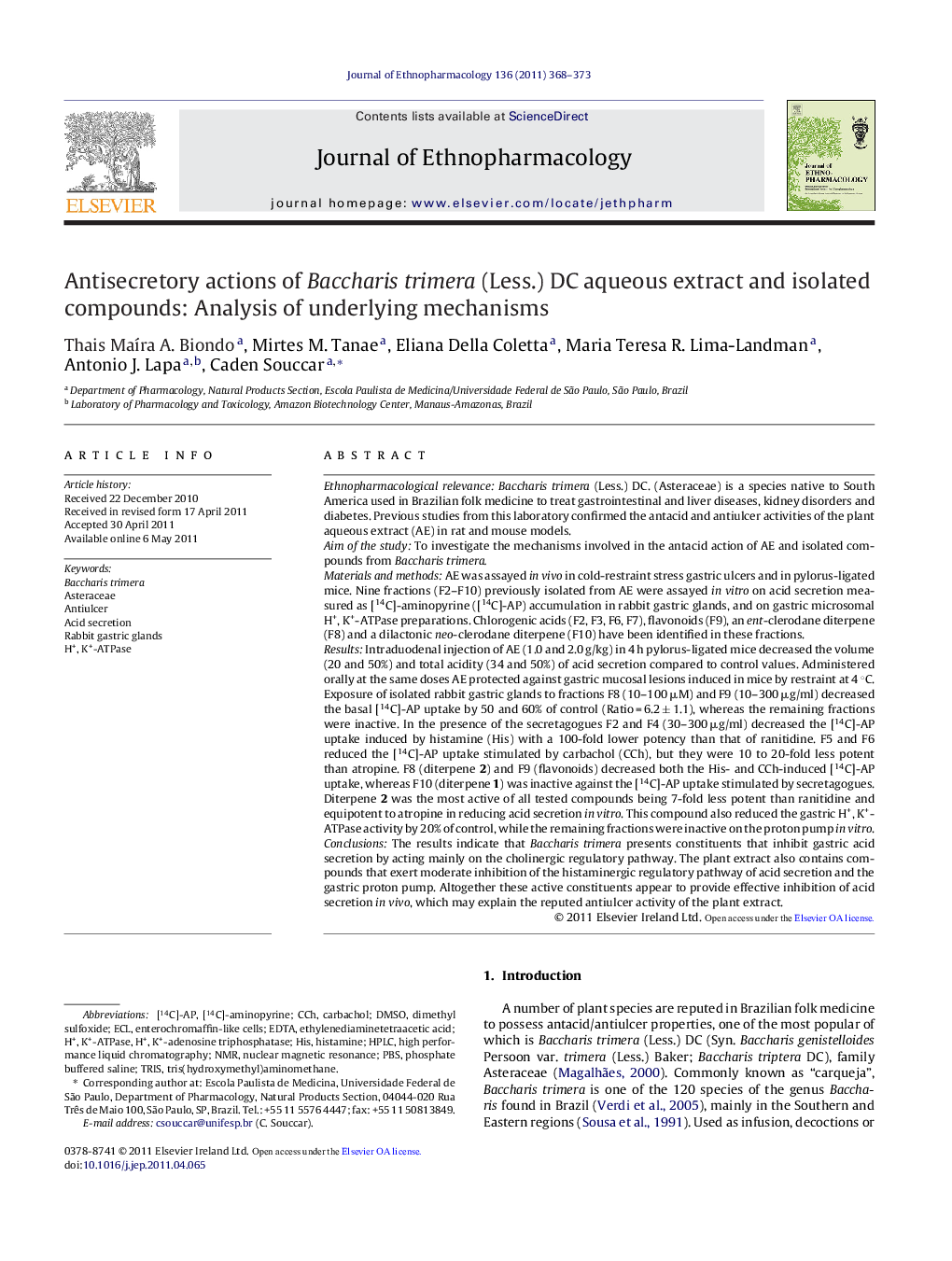| کد مقاله | کد نشریه | سال انتشار | مقاله انگلیسی | نسخه تمام متن |
|---|---|---|---|---|
| 5839072 | 1123986 | 2011 | 6 صفحه PDF | دانلود رایگان |

Ethnopharmacological relevanceBaccharis trimera (Less.) DC. (Asteraceae) is a species native to South America used in Brazilian folk medicine to treat gastrointestinal and liver diseases, kidney disorders and diabetes. Previous studies from this laboratory confirmed the antacid and antiulcer activities of the plant aqueous extract (AE) in rat and mouse models.Aim of the studyTo investigate the mechanisms involved in the antacid action of AE and isolated compounds from Baccharis trimera.Materials and methodsAE was assayed in vivo in cold-restraint stress gastric ulcers and in pylorus-ligated mice. Nine fractions (F2-F10) previously isolated from AE were assayed in vitro on acid secretion measured as [14C]-aminopyrine ([14C]-AP) accumulation in rabbit gastric glands, and on gastric microsomal H+, K+-ATPase preparations. Chlorogenic acids (F2, F3, F6, F7), flavonoids (F9), an ent-clerodane diterpene (F8) and a dilactonic neo-clerodane diterpene (F10) have been identified in these fractions.ResultsIntraduodenal injection of AE (1.0 and 2.0 g/kg) in 4 h pylorus-ligated mice decreased the volume (20 and 50%) and total acidity (34 and 50%) of acid secretion compared to control values. Administered orally at the same doses AE protected against gastric mucosal lesions induced in mice by restraint at 4 °C. Exposure of isolated rabbit gastric glands to fractions F8 (10-100 μM) and F9 (10-300 μg/ml) decreased the basal [14C]-AP uptake by 50 and 60% of control (Ratio = 6.2 ± 1.1), whereas the remaining fractions were inactive. In the presence of the secretagogues F2 and F4 (30-300 μg/ml) decreased the [14C]-AP uptake induced by histamine (His) with a 100-fold lower potency than that of ranitidine. F5 and F6 reduced the [14C]-AP uptake stimulated by carbachol (CCh), but they were 10 to 20-fold less potent than atropine. F8 (diterpene 2) and F9 (flavonoids) decreased both the His- and CCh-induced [14C]-AP uptake, whereas F10 (diterpene 1) was inactive against the [14C]-AP uptake stimulated by secretagogues. Diterpene 2 was the most active of all tested compounds being 7-fold less potent than ranitidine and equipotent to atropine in reducing acid secretion in vitro. This compound also reduced the gastric H+, K+-ATPase activity by 20% of control, while the remaining fractions were inactive on the proton pump in vitro.ConclusionsThe results indicate that Baccharis trimera presents constituents that inhibit gastric acid secretion by acting mainly on the cholinergic regulatory pathway. The plant extract also contains compounds that exert moderate inhibition of the histaminergic regulatory pathway of acid secretion and the gastric proton pump. Altogether these active constituents appear to provide effective inhibition of acid secretion in vivo, which may explain the reputed antiulcer activity of the plant extract.
The antiulcer activity of Baccharis trimera aqueous extract was related to the presence of constituents that inhibited gastric acid secretion in vivo. The most active compound, an ent-clerodane diterpene previously isolated (diterpene 2), inhibited acid secretion in vitro stimulated by carbachol (IC50 = 44 μM) and histamine (IC50 = 75 μM).94
Journal: Journal of Ethnopharmacology - Volume 136, Issue 2, 22 June 2011, Pages 368-373